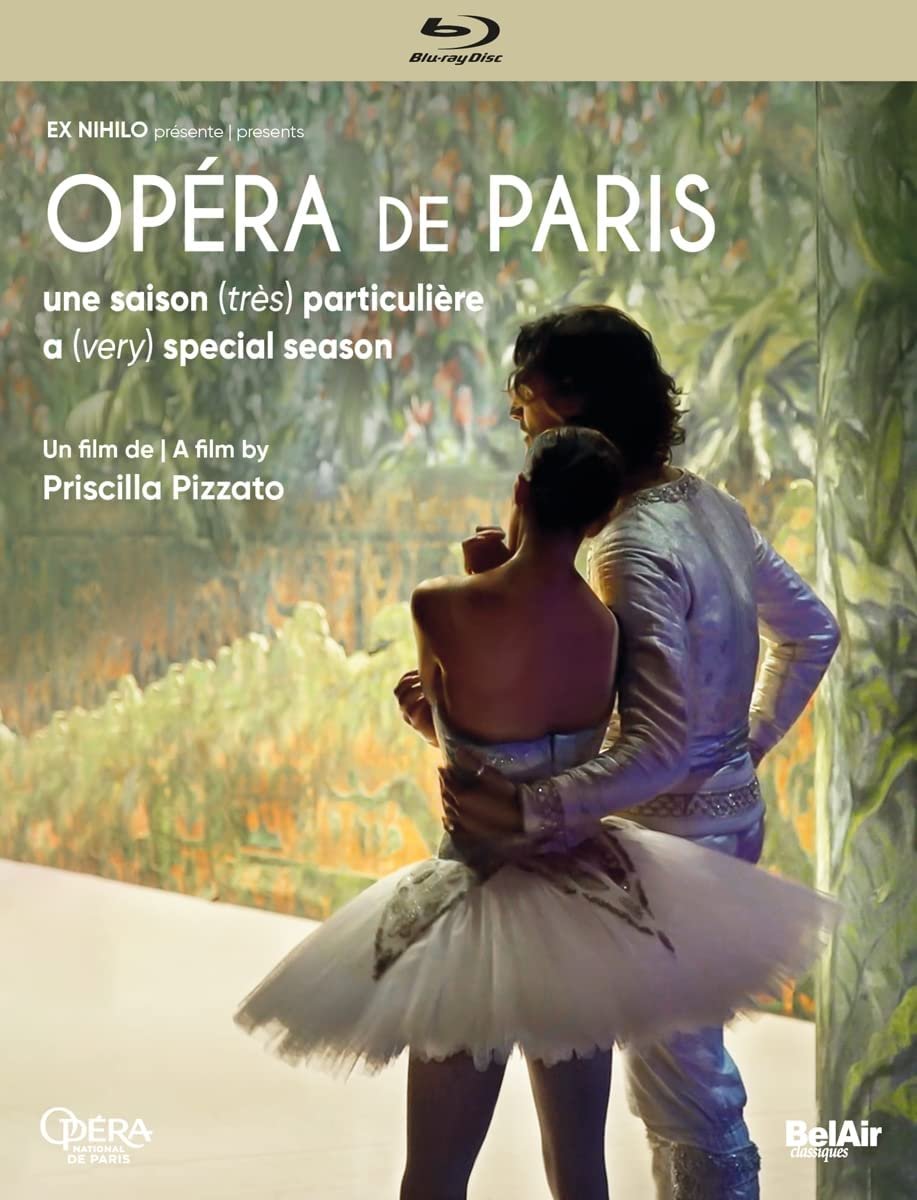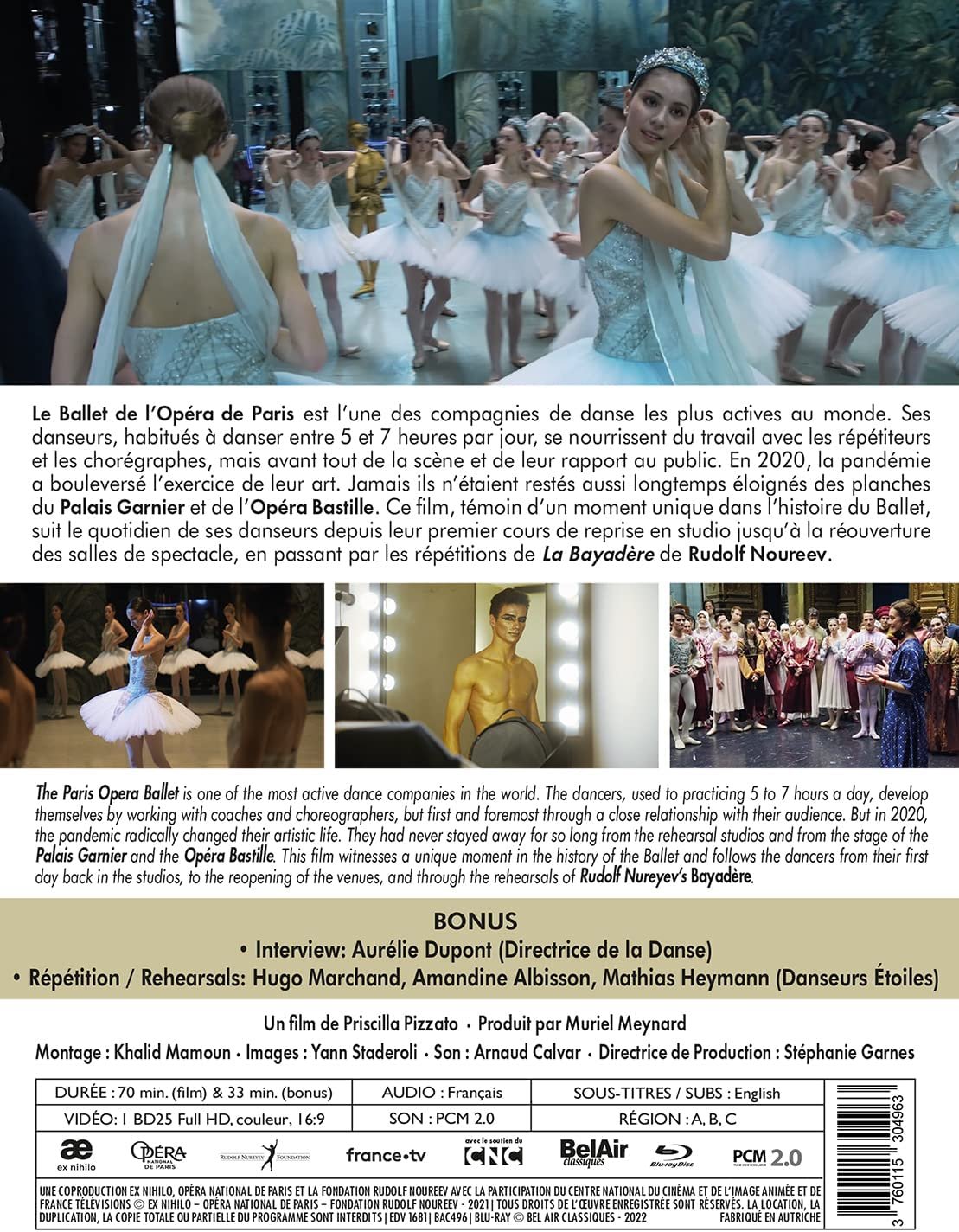

Opéra de Paris: A (Very) Special Season documentary film. Directed by Priscilla Pizzato. Cinematography by Yann Staderoli; edited by Khalid Mamoun; sound by Arnaud Calvar; production manager was Stéphane Garnes; produced by Muriel Meynard. Has bonus interview with Aurélie Dupont and rehearsal scenes with Hugo Marchand, Amandine Albisson, and Mathias Heymann. Released 2022, disc has 2.0 stereo sound. Grade: D+
This title gets off to a bad start because the name isn’t even correct. It’s not a documentary about the Paris Opera. It’s about the Paris Opera Ballet. So a correct name might be Le Ballet de l'Opéra de Paris: une saison (très) particulière. Too long! Maybe the name should be in English: Paris Opera Ballet v. Covid.
We already have La Danse, a “direct cinema” documentary about the Paris Opera Ballet shot in 2008 by Frederick Wiseman. Maybe Pizzato planed to update La Danse before the pandemic arrived. For sure the title we now review was an attempt to salvage something from a broken project. In a slightly shorter version it would make a decent forgettable hour on TV. But now we are asked to buy it and keep it on our shelf.
We mostly exclude documentaries on this website because we so often find them to be haphazardly thrown together with weak curation. But the picture on the cover was so pretty! So we bought. Now you see what we got.
The Paris Opera is unique with two famous active theaters going simultaneously: the old Garnier Palace (home of the Phantom) and the new Bastille (where the French revolution started). Pizzato assumes you know this. She provides beautiful images of both houses. The next two screenshots are slightly creative images of the exterior of the Garnier.
Note the golden lyres in the windows. You will see them again in some of the shots of dance rehearsals conducted in the Garnier rotunda:
The next three interior shots are from the Bastille house:
You might wonder who squats now on the top of the Paris Opera totem pole. In 2021 Alexander Neff, (succeeding Stéphane Lissner) arrived in the middle of the pandemic:
Aurélie Dupont directs and manages the Ballet. We know her from at least 5 Blu-ray ballet titles in which she starred. She is one of the most accomplished dancers in history blessed with leadership and administrative skills as well as supreme artistry. At age 42, the Paris opera dancers retire and look for new careers. Only a tiny number survive to stay in management. In a nice bonus interview, you get to see something of Dupont’s intellect and character:
Other fortunate survivors are the ballet mistresses and masters. They are like the staff sergeants in the military. Nothing happens without their technical knowledge and vast experience in the field.
Much of Pizzato’s video deals with the efforts of the company to mount their beloved Nurejev verison of La Bayadère. This includes the dreaded and exhausting walk down the ramp by the female corps. Each dancer is exposed to inspection for what seems like an eternity—and any mistake will be obvious to the audience.
Classes and rehearsals were cancelled for months and the women are rusty. Next below, Clotilde gives the girls a pep talk before they start practice on the ramp. She promises they will get their groove back, which they do:
So the surprise star of this title turns out to be Clotilde! In her frumpy clothes and goofy glasses, one might think she is the cleaning lady. But after seeing her at work, I reward her with a paraphrase, “ Hail to Thee, blithe Spirit / Scold thou never wert / That from heaven, or near it / Pourest thy full heart / In profuse strains of much premeditated art.” (Shelley)
Pissato’s libretto doesn’t explain that the La Bayadère show will have multiple casts. She assumes you know that. Various dancers appear without explanation. For example, below are two old-timers: Stéphane Bullion and Myriam Ould-Braham, both about to age out of the company. They are not identified by Pizzato, but I think they were cast as Solar and Nikiya in La Bayadère:
Other old-timers do get identified. For example, here is Dorothée Gilbert:
Next below we see a typical rehearsal scene with Gilbert dancing Nikiya. The men, who are hovering around the sacred temple fire, are not supposed to be watching her. But they can’t resist seeing how she is doing after the long Covid-19 break:
So much for the old stars. Pizzato is more interested in the young dancers like Hugo Marchand, who appears in the next three screenshots:
From the lyres in the windows, you know this is the rotunda rehearsal room in the Garnier:
Pizzato must be forgiven for being more interested in the young men than the young women. She does give a little attention to Amandine Albisson:
The guy who gets the most attention is Paul Marque, next seen below as First Dancer:
And here’s Paul again as Star. What gives?
Well, one of the spectacular acts in The Bayadere is the Dance of the Golden Idol. When Paul performs this for the dance masters in rehearsal, all the other dancers gather to see how he’s doing:
And now we see Paul in gold paint:
And after a performance as the Idol, Paul gets promoted to Star.
Some other stars noted are Mathieu Ganio, Mathias Heymann, and Germain Louvet. But we don’t learn much if anything about why they are stars:
These screenshot give you a pretty good idea about what’s covered in Pizzato’s video. If you have a chance to see this for free on one of the cultural TV channels in Europe, it could be a pleasant hour. But I would not want to urge you to spend money on this unless your have a special reason to want it. That results in a D+ under our grading scheme.
Here’s a trailer from BelAir:
OR





























